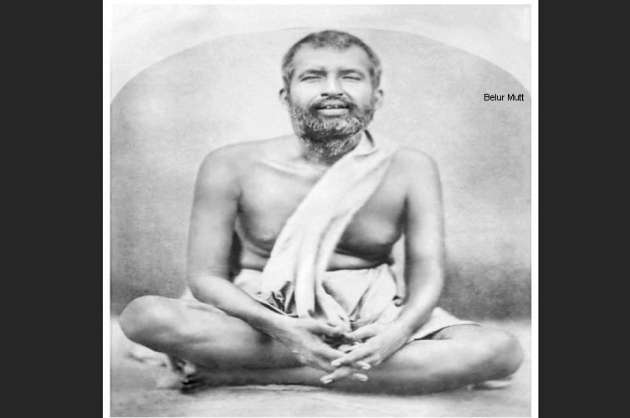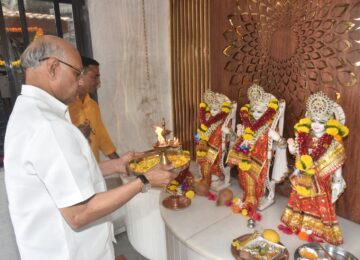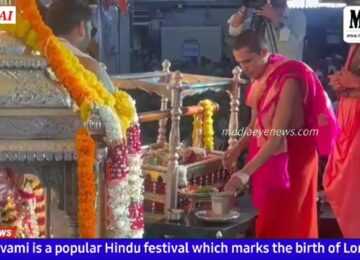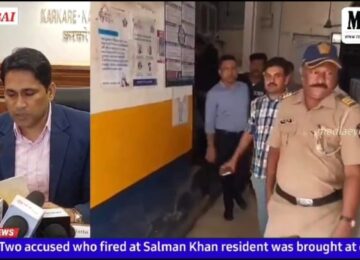Anupama Nair
www.mediaeyenews.com
Sri Ramakrishna was one of the greatest saints in India. In the last part I spoke about his birth, his enlightenment, his marriage to Sarada Devi and how he was appointed as the priest of Kali temple in Dakshineshwar. Today I am going to talk about his later life, how he met Swamiji and finally his battle with Cancer.
Sri Ramakrishna’s name began to spread across the country. Mathur (son-in-law) of Rani Rasmani) convened an assembly of scholars, and they declared him to be the Avatar of the Modern Age. In those days, the socio-religious movement known as Brahmo Samaj (founded by Raja Ram Mohan Roy), was very popular in Bengal. Brahmo Samaj was formed to reform the Hindu religion. His teaching on harmony of religions attracted many people belonging to different communities, and Dakshineswar became a “Parliament of Religions”.
In 1875, Sri Ramakrishna met the influential leader of Brahmo Samaj Keshab Chandra Sen. Keshab had accepted Christianity, and had separated from the Adi Brahmo Samaj. Keshab had rejected idolatry, but under the influence of Ramakrishna he accepted Hindu polytheism and established the "New Dispensation" or “Nava Vidhan”, based on Ramakrishna's principles of "Worship of God as Mother", "All religions are true" and "Assimilation of Hindu polytheism into Brahmoism". Sen published Ramakrishna's teachings in the journals of New Dispensation over a period of several years, that was instrumental in bringing Ramakrishna to the attention of a wider audience, especially the Bhadralok (English-educated classes of Bengal) and the Europeans residing in India.
Many of the prominent people of Calcutta, Pratap Chandra Mazumdar, Shivanath Shastri and Trailokyanath Sanyal visited him in the period from 1871–1885. Mazumdar was the author of the first English biography of Ramakrishna, “The Hindu Saint” in the “Theistic Quarterly Review (1879), that played a vital role in introducing Ramakrishna to Europeans like the German Indologist (study of India) Max Mueller. Newspapers of that time reported that Ramakrishna was spreading "Love" and "Devotion" among the educated classes of Bengal and that he had succeeded in reforming many youths with corrupt morals. Sri Ramakrishna also had interactions with Debendranath Tagore (father of Rabindranath Tagore), and the great Ishwar Chandra Vidyasagar, who was a renowned social worker. He had also met the founder of Arya Samaj, Dayanda Saraswati. Sri Ramakrishna was considered one of the main contributors to the Renaissance in India,
Then happened a chance meeting with a young student Narendranath Dutta, who was an atheist that changed the course of Indian history and world’s concept of India. Among the Europeans who were influenced by Sri Ramakrishna was the Principal of the Scottish Church College, Calcutta Mr. William Hastie. While explaining the word trance in the poem “The Excursion” by William Wordsworth, Hastie told his students that if they wanted to know its "real meaning", they should go to "Ramakrishna of Dakshineswar." This prompted some of his students, including Naren to visit Ramakrishna.
It is said he asked several prominent Calcutta residents if they had come "face- to-face with God", but none of their answers gave him satisfaction. At this time, Narendra met Debendranath Tagore, and asked if he had seen God. Instead of answering his question, Tagore said "My boy, you have a Yogi’s eyes." According to Banhatti, a historian it was Sri Ramakrishna who really answered Narendra's question, by saying "Yes, I see Him as I see you, only in an infinitely intense sense." It was also due to Sen that he met his Guru and idol Sri Ramakrishna in 1881.
In late 1881 or early 1882, Narendra went to Dakshineswar with two friends and met Sri Ramakrishna. This meeting proved to be a turning point in the life of Naren. Although, he did not initially accept Ramakrishna as his teacher and rebelled against his ideas, he was attracted by his personality and began to frequently visit him at Dakshineswar. He initially saw Sri Ramakrishna's ecstasies and visions as "mere figments of imagination" and "hallucinations". As a member of Brahmo Samaj, he opposed idol worship, polytheism and Ramakrishna's worship of Devi Kali. He even rejected the Advaita Vedanta of "identity with the absolute", and often ridiculed the idea. Narendra even tested Sri Ramakrishna, who faced his arguments patiently, "Try to see the truth from all angles", he replied to his shishya
Narendra's father's sudden death in 1884 left the family bankrupt, creditors began demanding the repayment of loans, and relatives threatened to evict the family from their ancestral home. Narendra, once a son of a well-to-do family, became one of the poorest students in his college. He unsuccessfully tried to find work and became an atheist. He found solace in Sri Ramakrishna and his visits to Dakshineswar became more frequent
One day, Narendra requested Sri Ramakrishna to pray to Devi Kali for their family's financial welfare. Ramakrishna advised him to go to the temple himself and pray. Following Sri Ramakrishna's suggestion, he went to the temple thrice, but failed to pray for any kind of worldly necessities and ultimately prayed for true knowledge and devotion from the Devi. Narendra gradually grew ready to renounce everything for the sake of God realization, and accepted Sri Ramakrishna as his Guru.
Sri Ramakrishna did not write any book, nor did he deliver public speeches. Instead, he chose to speak in a simple language using parables and metaphors by way of illustration, drawn from the observation of nature and ordinary things of daily life. His conversations were charming and attracted the cultural elite of Bengal. These conversations were noted down by his disciple Mahendranath Gupta who published them in the form of a book, “Sri Ramakrishna Kathamrita” in Bengali and “The Gospel of Sri Ramakrishna” in English, and these books are popular even today.
In the beginning of 1885, Sri Ramakrishna suffered from clergyman's throat, which gradually developed into throat cancer. The best medical treatment available at that time was provided to him, but his condition aggravated and he left his mortal body on 16 August 1886 in Cossipore. Narendra decided to convert a dilapidated house at Baranagar into a new matt for the remaining disciples. Rent for the Baranagar Matt was low, raised by "holy begging". The matt became the first building of the Ramakrishna Matt, the monastery of the monastic order of Sri Ramakrishna. Narendra and other disciples used to spend many hours in practicing meditation, and religious austerities every day.
On the Christmas Eve of 1886, Narendra and eight other disciples took formal monastic vows. They decided to live their lives as their master Sri Ramakrishna lived. In 1888, Narendra left the monastery as a Parivrâjaka— the Hindu religious life of a wandering monk, "without fixed abode, without ties, independent and strangers wherever they go". His sole possessions were a kamandalu (water pot), staff and his two favorite books: The Bhagvad Gita and the Imitation of Christ written by Thomas Kempis. Narendra travelled extensively in India for five years, visiting centers of learning and familiarizing himself with diverse religious traditions and social patterns. He developed sympathy for the suffering and poverty of the people, and resolved to uplift the nation. Living primarily on bhiksha (alms), Narendra travelled on foot and by railway (with tickets bought by admirers). During his travels he met, and stayed with Indians from all religions and walks of life –scholars, dewans, rajas and government officials. He adopted the name Vivekananda.
In the next part I will talk about the establishment of Sri Ramakrishna Mission. At the outset, it was Sri Ramakrishna, Sarada Devi and Swamiji who inspired me to write this article. I am only an instrument and it was Mother Kali who came as thoughts in my mind, which got converted into words.
(To be continued…)
(Dedicated to Ramakrishna Mission –Trivandrum, Vivekananda Ashram – Kanyakumari, Ramakrishna Mission School – Jamshedpur, and Belur Matt – Calcutta. Picture courtesy Belur Mutt)





























Good article. It makes us proud of our rich heritage. Would love to see more such articles in the future. Media Eye is great platform. Keep up the good work.
Good article
Again well written Anu.
Waiting eagerly for the third part.
Remember my trip to Calcutta
Good article
Anupama and Media eye should publish more such articles showcasing Indian spirituality
Jai Gurudev
Jai Gurudev
Jai Gurudev
Hai Gurudev. Please fill the world with the light of knowledge.
Nice article.
Nice article.
Nice article.
Great guru
Jai Guru dev
Jai Guru Dev and Maa
Jai Guru Dev and Maa
Jai Guru Dev and Maa
Good article. Loved it.
Jai gurudev
Jai Guru dev
Full of spirituality
Full of spirituality
Full of spirituality
Great gurus of India.
Jai Guru Dev.
Jai gurudev
Jai gurudev.
Jai gurudev.
Jai gurudev
Jai Gurudev.
Jai gurudev
Great Guru of India.
Greatest Gurus of all time.
Greatest Gurus of all time.
Greatest Gurus of all time.
Great saint.
Great Guru.
Great Guru.
Great article.
Great article.
Can see how Anupama wrote it brilliantly.
Jai gurudev
Jai Guru Dev.
Jai Guru Dev.
Jai gurudev
Jai gurudev
Great guru.